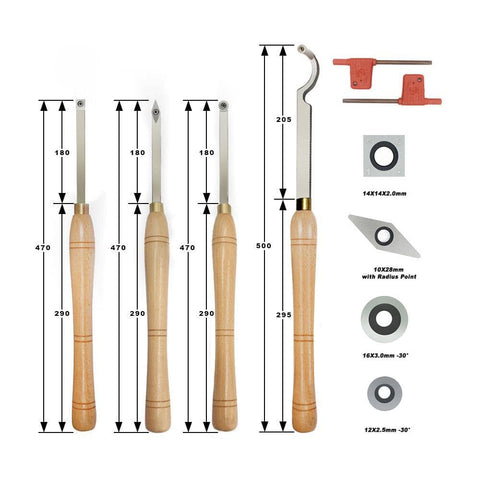Turning with Caution: Can Normal Chisels Be Used for Woodturning?

Woodturning is a unique branch of woodworking that relies on specialized tools designed to withstand the forces exerted on the wood as it spins at high speeds. This craft involves cutting and shaping wood on a lathe to produce objects like bowls, spindles, and intricate decorative pieces. The tools commonly used in woodturning are lathe chisels, specifically engineered for the task, but it's not uncommon for beginners to wonder if standard woodworking chisels can serve as substitutes. While it's possible to use regular chisels for woodturning, it's generally discouraged due to performance, durability, and safety concerns.
One of the main reasons standard woodworking chisels are not recommended for woodturning is the difference in design and purpose. Normal chisels are intended for carving, paring, or hand-sculpting wood, often with slow, controlled movements. They are typically used with wood that remains stationary. Woodturning tools, on the other hand, are engineered for the dynamic environment of a lathe, where wood rotates at hundreds or even thousands of revolutions per minute. This creates much higher forces on the cutting edge, which a standard chisel isn't built to handle. The metal in woodturning chisels is designed to withstand the heat and friction generated by constant contact with fast-spinning wood, while standard chisels often cannot endure these demands without risking dulling or chipping.
Another key difference between normal chisels and woodturning chisels lies in the shape and grind of the cutting edge. Traditional woodworking chisels are usually flat or beveled on one side, designed for controlled, steady cuts into static material. Woodturning chisels, however, are often ground with a rounded bevel or flute, which allows for a smoother transition across the rotating wood. This curved grind helps woodturners control the tool more precisely and reduces the risk of "catches," sudden jerks that occur when the tool digs too deeply into the wood. A standard chisel lacks this ergonomic design, making it much harder to control and increasing the risk of mishaps when applied to a spinning workpiece. For this reason, using a standard chisel on a lathe can lead to unpredictable cuts, poor surface quality, and potential tool chatter.
The handle length is another significant factor to consider. Normal woodworking chisels have shorter handles designed for close, precise work, but they don't offer the leverage required to handle the forces involved in woodturning. Woodturning chisels have long handles, allowing the user to brace the tool against their body or on the lathe's tool rest for stability and control. Without this longer handle, a standard chisel is much harder to hold steady, making it more challenging to guide and more prone to slipping or twisting under pressure. For new turners, this lack of control can be dangerous, as the tool may become unstable and even cause injury.
Heat buildup is another important concern. Woodturning generates a great deal of friction, which produces heat that can affect a tool's edge retention. Woodturning chisels are generally made from high-speed steel (HSS) or carbide, materials that can withstand high temperatures without losing their hardness. Normal chisels, typically made of carbon steel, tend to lose their edge faster under these conditions, requiring frequent resharpening. A dulled edge on a wood lathe is not only frustrating but also risky, as it increases the likelihood of catches. Furthermore, constant resharpening wears down the tool faster, reducing its overall lifespan and making it a less practical choice for woodturning.
Safety is perhaps the most compelling reason to avoid using standard chisels on a lathe. The high-speed rotation of wood on a lathe combined with the forces exerted on a chisel creates a challenging environment that calls for specialized tools. Standard chisels are more prone to failure under these stresses, as they are not designed to handle the lateral and radial forces exerted during woodturning. A chisel that breaks or chips on the lathe can be hazardous, as pieces of metal may become airborne. Additionally, the increased risk of catches or slips with a standard chisel can lead to injury. Proper woodturning chisels are designed with safety in mind, ensuring that they can perform under the demanding conditions of the lathe.
If you're in a situation where you don't have access to woodturning tools and are considering using normal chisels for a quick or experimental project, extreme caution is advised. Limit the lathe speed to reduce stress on the tool, and work with softer woods that generate less friction. Always wear protective equipment, including eye protection and possibly a face shield, and be mindful of the tool's limitations. However, even with these precautions, the results are likely to be suboptimal, and you may find that the effort and risk outweigh the potential benefits.
Investing in a basic set of woodturning chisels is strongly recommended for anyone serious about woodturning. The spindle roughing gouge, spindle gouge, bowl gouge, and parting tool each serve a specific function and are engineered for the unique demands of woodturning. With these tools, you'll not only achieve better results but also work with greater confidence and safety. Proper woodturning tools are designed to deliver a smoother cut, a finer finish, and, ultimately, a more enjoyable and rewarding experience on the lathe.
In conclusion, while it's technically possible to use normal chisels on a wood lathe, it's far from ideal. The limitations in design, durability, and safety make standard chisels a poor substitute for dedicated woodturning tools. For the best results and a safer, more controlled experience, specialized woodturning chisels are the way to go. With the right tools in hand, woodturning becomes a journey of skill and creativity, one that promises years of enjoyment and the satisfaction of crafting beautiful, unique pieces from raw wood.

